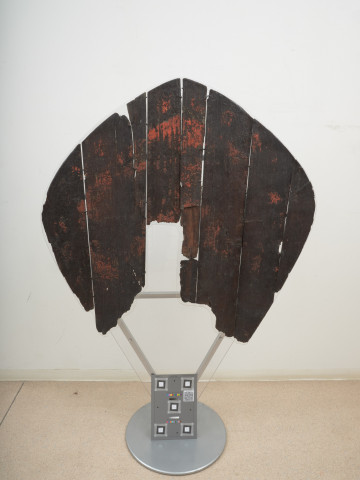
Wooden shield
1176 — 1200
National Museum in Szczecin
Part of the collection: Middle Ages
I. A double-edged iron sword, dredged at the end of the 19th century from the Oder riverbed at the height of the present-day Szczecin Gocław housing estate, known as the Szczecin-Gocław I sword. The Gocław I sword is complete. The head, the part of the sword used for striking, has a wide armour in the form of an indentation visible almost its entire length. It was made in the so-called bar technique with knitting, i.e., joining soft and hard elements alternately. Blade caps were made of layered strips with different degrees of carburising. The sword handle has a short, massive hilt (protection for the hand), which in its lateral cross-section resembles an octagon, and a two-part head (the end of the sword handle serving as a counterweight and decoration). Traces of organic linings were found on the hilt bolster, rectangular and tapers slightly towards the head. The Szczecin-Gocław I sword is distinguished by the presence of an ornament in the form of thin vertical stripes made of a copper-zinc alloy. In the 1939 systematics of early medieval swords by H. Jahnkuhn, the sword was assigned to the Mannheim type. Two such specimens, made in Germany and southern Scandinavia between the mid-8th and early 9th centuries, are known from Poland.
Sławomir Słowiński
Author / creator
Dimensions
cały obiekt: height: 94.4 cm, width: 4.94 cm
Object type
sword, weapon
Technique
grinding, soldering, forging
Material
brass, iron
Origin / acquisition method
legal transfer
Creation time / dating
Creation / finding place
Owner
Muzeum Narodowe w Szczecinie
Identification number
Location / status

1176 — 1200
National Museum in Szczecin

1001 — 1100
National Museum in Szczecin

901 — 1100
National Museum in Szczecin
DISCOVER this TOPIC
National Museum in Lublin
DISCOVER this PATH
Educational path